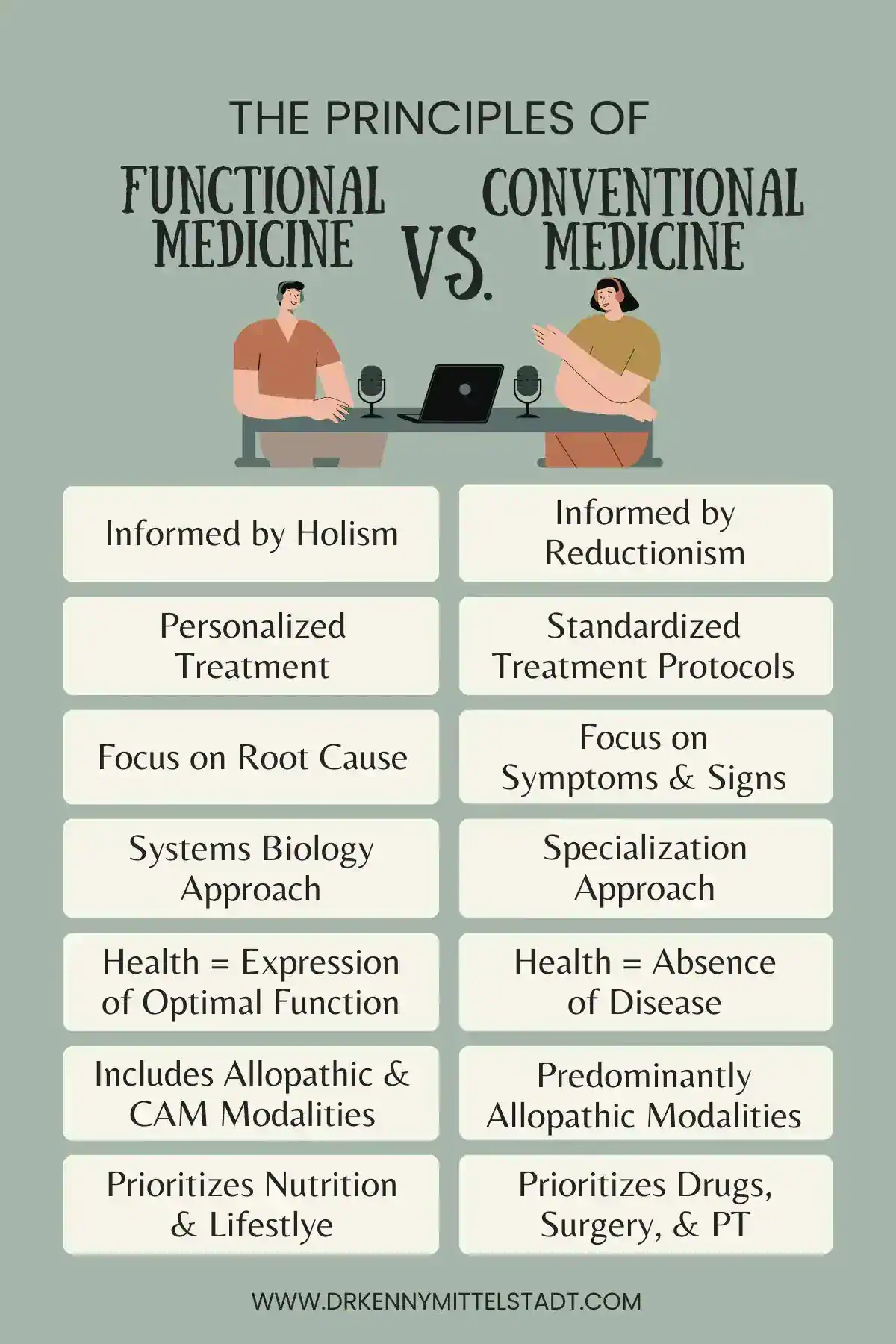7 Core Principles That Set Functional Medicine Apart From Conventional Care
A systems-based lens on healing that moves beyond symptom suppression.
Sometimes, I like to share this maxim with my patients. “When you can define something, you can deal with something.” Part 2 of this blog series exploration of the principles of functional medicine vs. conventional medicine is all about further defining and understanding each paradigm.
In Part 1, we defined both functional medicine and conventional medicine and introduced key differences. In this section we are going to delve further into the ideologies and principles that inform these lenses through which we can practice healthcare.
Now, the goal of Part 2 is to leave with a more personalized understanding of the undertones of both systems to hopefully tease out what resonates more profoundly with you!
Overall, I will attempt to deliver the information as objectively as possible and leave the deduction up to you!
Altogether, I hope you find more information and empowerment through this exploration of functional medicine vs. conventional medicine!
Feel free to refer to this infographic as a summary of the major principles we’re going to be exploring!

7 Key Principles of the Functional Medicine Paradigm
To begin, let’s take a closer look at the principles that inform functional medicine.
1. A Holistic Approach to Health
A foundational concept of functional medicine is holism. For starters, an important concept that underlies holism is that the “whole is greater than the sum of its parts.” When applied to human health, holism implies that each component is intricately intertwined, interdependent, and inseparable.
Unlike conventional medicine, which focuses predominantly on the physical, currently measurable world of health (symptoms, body metrics, pathogens, genetics, nutrients, movement etc.), functional medicine also draws attention to other important factors through holism.
To elaborate, these are some factors that are considered important to holistic health:
- Physical Health
- This includes everything from microscopic to macroscopic that determines our physical health
- Movement, nutrition, physical pain, infections, genetic expression, hormones, etc.
- Mental Health
- Including thoughts, cognitive processing, and perception of self and non-self
- Emotional Health
- The experience and regulation of human emotion
- Social Health
- Support systems, communication, community, and connection
- Spiritual Health
- Our deepest sense of purpose, drive, and meaning; our relationship with something greater
When functioning ideally, each of these components contribute to the creation of holistic health. But on the flip side, when imbalanced, each can also contribute to the development of disease and dysfunction. Functional medicine takes all of these into account.
2. Treatment is Personalized to the Patient
Given the introduction to holism above, you might then realize that there is infinite complexity when considering each individual’s holistic health. I always frame this idea to patients that “we are each a unique sum of our individual experiences.
Considering this, functional medicine treatment is unique for each individual. Treatment plans often involve comprehensive interventions including lifestyle support, nutrition, movement, nutraceuticals, and more depending on the patient. Everything depends on the individual patient.
Rather than treatment being focused on the individual signs, symptoms, or diagnoses alone, the person is viewed holistically and individually.
3. A Focus on Root Causes for Disease and Dysfunction
With these undertones of holism and personalized care, we set the stage for the concept of “root cause” medicine. Functional medicine attempts to identify underlying root causes of dysfunction leading to one’s clinical predicament.
A holistic, comprehensive approach helps to tease out intricate, sometimes seemingly unrelated details to identify the root cause of disease and dysfunction..
Another way to frame the “root cause” is to consider the root, the “why” of disease and dysfunction. In functional medicine the “why” is the most important thing to influence if possible. It may be nutritional deficiencies, inadequate movement, exposure to toxins, genetic expressions, and the list goes on.
In contrast, conventional medicine focuses mostly on the “what” in disease and dysfunction. Describing symptoms and the process of diagnosis are all ways to characterize the “what.”
I like to use this analogy for a root-cause approach:
To start, imagine that your body is a luxury vehicle. With functional medicine, the focus lies on the quality of the gasoline and regular maintenance as the root of ideal functioning. In contrast, using a fire extinguisher when the engine catches fire or replacing the engine is parallel with a conventional medicine focus – proactive rather than reactive.
Functional medicine recognizes the power of creating health from the inside out (nutrition, movement, stress management, immune function, etc.).
4. The “Systems Biology” Approach
Next, an important perspective that underlies functional medicine is in its “systems biology” approach. This concept highlights the interconnectedness, complex, and dynamic nature of our biology. We are infinitely complex beings, and functional medicine takes this into account.
In essence, this concept recognizes that treating one area of the body will likely have a multitude of influences on other systems of the body. It also suggests that multiple factors may contribute to a single manifestation of disease and dysfunction.
Feel free to look up “Systems Biology” if this topic interests you. Here’s an academic article discussing systems biology and functional medicine if you want a deeper dive!
This perspective is opposite that of conventional medicine and clinical research. These approaches attempt to strip away the complexity to find a single cause that pairs with a single intervention. (Dr. Mark Hyman, a functional medicine pioneer and expert describes this as “a pill for an ill”).
5. Health is Defined as the” Expression of Optimal Function”
In functional medicine, health is not just the absence of disease or symptoms. Rather health is the expression of optimal functioning of all the processes that make us alive. Health occurs when all aspects are thriving – Physically, energetically, mentally, socially, and spiritually.
6. Open to Both Allopathic and CAM Practitioners
Unlike conventional medicine, functional medicine is a paradigm that includes allopathic practitioners and complementary and alternative medicine (CAM) practitioners alike. Functional medicine is a lens through which any practitioner can look.
Allopathic practitioners (MD’s, DO’s, PA’s, nurses, PT’s, mental health professionals, etc.) currently represent the largest percentage of functional medicine practitioners. Also noteworthy is the inclusion of naturopaths (ND’s), chiropractors (DC’s), acupuncturists (L.Ac.’s), and more.
Functional medicine training is open to any and all healthcare practitioners. However, a practitioner’s scope of practice is still dictated by their educational degree and licensure. For more information on functional medicine training check out the pioneering Institute for Functional Medicine’s website.
7. Treatment Prioritizes Nutrition and Lifestyle
Generally speaking, functional medicine recognizes the power of nutrition and lifestyle interventions as primary treatment interventions. Poor nutrition and lifestyle habits are at the root of most chronic illnesses we experience in today’s day and age.
To emphasize, drugs, surgery, and other allopathic interventions are certainly on the table within the functional medicine paradigm. But there is much support and prioritization toward nutrition and lifestyle interventions and supporting holistic health.
Potential functional medicine treatment interventions may include:
- Nutraceuticals (Vitamins, minerals, omega 3’s, antioxidants, etc.)
- Herbs & Botanicals
- Movement & Exercise Plans (Yoga, resistance training, aerobics, etc.)
- Mind-body therapies (Tai Chi, Qi Gong, Meditation, Breathwork, etc.)
- Pharmaceuticals (hormone replacement therapy, antibiotics and antifungals, etc.)
- Dietary changes (Mediterranean diet, elimination diets, low FODMAP diet, etc.)
- Sleep hygiene
- Stress management
- Counseling & Psychotherapy
- Mindfulness practices
- Environmental toxin elimination (detoxification strategies, reduced exposure, etc.)
- Genetic testing
- Integrative therapies (acupuncture, chiropractic, ayurveda, etc.)
- Other therapies (hyperbaric oxygen therapy, hot/cold therapies, magnets, sound, etc.)
This wraps up our exploration of 7 key principles that underlie functional medicine. As we continue with our discussion on conventional medicine’s principle, you may notice some direct comparisons.
Let’s continue with the next component o functional medicine vs. conventional medicine – Part 2!
7 Key Principles of the Conventional Medicine Paradigm
1. A Reductionist Approach to Health
Reductionism is a key theory that underlies the conventional medicine approach. In essence, reductionism is the idea that we can understand and treat disease by breaking down complexity into smaller and smaller pieces. (i.e. systems -> organs -> cells -> molecules, etc).
The belief within reductionism is that by understanding and isolating the fundamental building blocks of the body’s processes, that it will lead to the most effective treatment interventions.
Understanding reductionism should then make sense of many components within conventional medicine:
- Specialization – A focus on specific organs or systems by a practitioner (specialities)
- Clinical research – Founded on reductionism, which informs the design of randomized clinical controlled trials – The intention is to keep all variables constant except for the one you’re trying to measure
- Pharmaceuticals – Drugs target specific chemical processes in the body that are thought to be responsible for causing or playing a role in disease and dysfunction
- Diagnostic testing – Certain lab findings and ranges are deemed important. So these may inform further testing or trigger treatment algorithms
- Disease classification – There is a focus on diseases and diagnosis. They are based on a collection of symptoms and lab findings and treated as a distinct “entity.”
Reductionism is rooted in the physical world. It highlights what we are able to observe and measure up to the present moment.
Can you see how conventional medicine – including research, diagnostics, and treatment – is informed through the lens of reductionism? This contrasts holism that informs functional medicine as described above!
2. Standardized Treatment Protocols
The care process in conventional medicine is algorithmic in nature. As such, treatment is often tailored to each classification of disease as an entity itself rather than to the entire patient.
Reframed, once a diagnosis is named or given, it signals a cascade of treatment options to begin. Treatment usually begins with pharmaceuticals, surgery, and other options.
Treatment protocols become standard of care through the inherent reductionistic processes of research and statistics. Recommendations are then based on the body of available evidence at any given time.
3. Focus on Symptom and Sign Mitigation
In conventional medicine, identifying and managing the symptoms and signs are the primary focus of care. What is the difference between symptoms and signs?
- Symptoms – The subjective experience of disease; the sensations and feelings that are apparent to the patient (“I feel pain, I feel fatigue”, etc.)
- Signs – The objective findings of disease; the manifestations of health concerns that a practitioner can observe and measure (body temperature, finding bacteria in the urine during a UTI, etc.)
Therefore, the definition of treatment success is a relief or reduction of symptoms or signs. This may be pain relief, a fever receding, or an ideal change in lab markers such as blood work, urine testing, or imaging studies.
For example, let’s say a person comes in with high cholesterol. With the conventional medicine lens, this patient might be prescribed a drug that lowers this marker to “normal” ranges. When lowered, this treatment is considered successful.
Let’s contrast this example with a root-cause focus of functional medicine. A patient presents with high cholesterol and the next step would be to understand the WHY, or the root cause(s). They would consider high saturated fat and trans fat intake, genetics, lack of movement or exercise, suboptimal liver function and detoxification pathways, and the list goes on.
4. Specialization and Resulting Healthcare “Silos”
Specialization is another property inherent to conventional medicine. Though a general practitioner is often a first line coordinator of patient care, specialization mirrors the reductionist approach. Specialists govern certain regions of the body or processes and deliver care specific to those areas.
The result is that patients often have many practitioners they may report to – their primary care physician, their heart doctor, their lung doctor, and their hormone doctor for instance. Care is effectively sectioned into silos based on the region of focus.
5. Health is Defined as the “Absence of Disease”
Rather than health being defined by the expression of optimal function, conventional medicine views health as the absence of disease. This may sound like the exact same situation to you but let me use the following example to illustrate the difference.
A patient comes into my practice after receiving their most recent blood test results from their conventional primary care physician. During their visit, they didn’t have any classic symptoms related to diabetes. However, they wanted to explore their findings related to blood sugar and screening for diabetes.
Before we continue, let’s understand a basic concept of blood sugar as it relates to diabetes. HbA1c is a common blood test marker that helps screen for diabetes. To translate, HbA1c is basically a summary measurement for how sugar has impacted your blood cells over the last 120 days.
- An HbA1c below 5.7% is considered normal
- An HbA1c between 5.7% – 6.4% is considered pre-diabetes
- An HbA1c above 6.5% is considered diabetes
This patient’s HbA1c was 5.6%, which is considered normal within the context of the above conventional ranges. The patient asked their primary care practitioner and me the same question. “What should/could I do?”
Conventional Medicine Practitioner Answer: “We’ll just wait. Once your HbA1c gets to 5.7% or higher we might consider prescribing medications to help lower your blood sugar. And eat less sugar”
Functional Medicine Practitioner Answer: “Let’s talk more about your movement, nutrition, and family history. There are many factors that contribute to blood sugar issues and ways that we can optimize to slow or even reverse the progression of these blood test results.”
Do you see how this illustrates the different definitions of health – the absence of disease with conventional medicine versus the expression of optimal health in functional medicine?
6. Reserved for Allopathic Practitioners
This characteristic is quite self explanatory. The educational and licensure pathway is relatively standard throughout the nation and even the world when it comes to training conventional medical practitioners.
The pathways to most conventional medicine careers are generally straightforward and well-defined. Many include undergraduate education, graduate work, and clinical training such as internships and residency programs. Such degrees in the conventional model include MD, DO, PA, PT, or nursing degrees.
Some allopathic practitioners may pursue an integrative medicine approach (working with non-allopathic practitioners closely). However, integrative medicine is not woven into the regular curriculum or practice of most conventional practitioners.
7. Treatment Prioritizes Drugs and Surgery
Considering the algorithmic, mass market, and research-based approaches to care, treatment often consists of standardized protocols. As we explored above, symptoms and formal diagnoses generally lead to treatment pathways and referrals.
Typical interventions within conventional medicine heavily weigh pharmaceuticals, medication, and surgical interventions. Physical therapy and clinical nutrition are also treatment options.
Conclusion of Part 2 of Functional Medicine vs. Conventional Medicine:
Hopefully, this exploration of the underlying principles of both functional medicine have left you with a deeper understanding of the situation!
With this information, you can hopefully determine what principles you resonate most with. You might prefer a holistic approach or reductionist approach, root cause versus symptom management, or drugs and surgery over nutrition and lifestyle interventions. Regardless, your options are hopefully laid out here!
Explore to your heart’s content!
In the final section of this blog post series on functional medicine vs. conventional medicine, Part 3 will focus on exploring drawbacks and limitations of each paradigm, FAQ’s, and concluding thoughts!
Feel free go back to Part 1 if you need, and I wish you the very best in this journey.
Remember that “health is contagious, share the love.” Remember to comment or share this post with a friend, or follow and reach out to me on Instagram! I’d love to further the conversation!
About the Author
Dr. Kenny Mittelstadt is a root-cause health detective and functional medicine practitioner practicing in Texas, California, and Florida. Trained through the Institute for Functional Medicine with dual doctorates earned at highest honors from Southern California University of Health Sciences, he helps patients solve complex health issues naturally using advanced functional lab testing and personalized holistic care instead of conventional medications.

